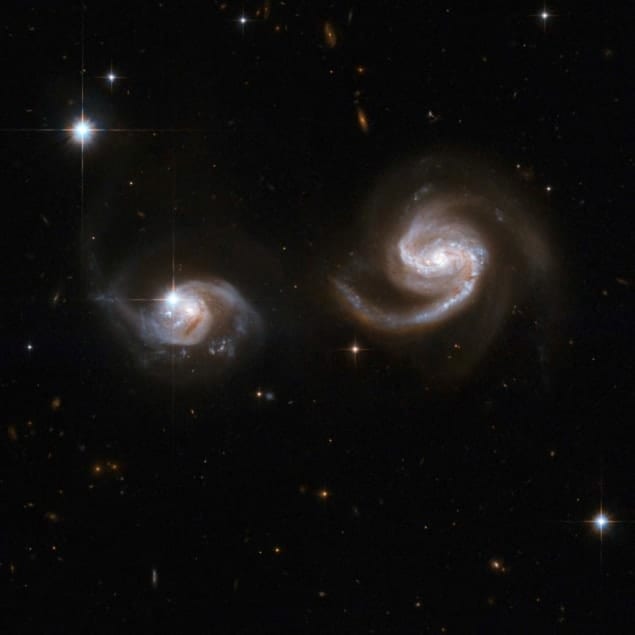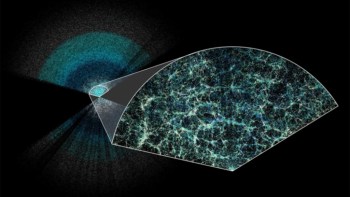
A new way of measuring the geometry of the universe confirms that dark energy dominates the cosmos and bolsters the idea that this unusual form of energy is described by Einstein’s cosmological constant. The technique, developed by physicists in France, involves a relatively easy measurement of the orientation of distant pairs of galaxies.
Over the past decade or so, several kinds of observation, such as measurements of the distances of remote supernovae, have provided strong evidence that the expansion of the universe is accelerating. Cosmologists believe that this expansion is being driven by what is known as dark energy – a substance with negative pressure that opposes the pull of gravity. Unfortunately, however, they have little idea of what dark energy actually is, having been unable to measure its properties well enough to distinguish between rival hypotheses.
The new approach, devised by Christian Marinoni and Adeline Buzzi of the University of Provence in Marseille, should help narrow down the options as well as provide another means of working out the geometry of space. It involves comparing the known shape of very distant objects with the shape of those objects as revealed by astronomers’ observations. Astronomers don’t measure distances, and hence shapes, directly, but instead measure the extent to which the wavelength of radiation from a distant object has increased – or redshifted. This tells them the speed at which the object and Earth are moving apart.
Unusual geometry
Hubble’s law states that the speed at which objects within the universe move apart from one another is proportional to the distance between them, so knowing the speed of a distant object reveals how far away it is (although this is only approximately true at very great distances). But if the space between that object and the measurer has an unusual geometry or if the expansion of the universe is actually accelerating then the distance measured will not be accurate. So the idea is to vary the quantities that represent the geometry and the strength of dark energy until the distances of interest match up with expectations.
This principle was first proposed by the astronomers George Alcock and Bohdan Paczyński in 1979 but has been difficult to carry out in practice because the redshift due to the local motions of the objects themselves tends to mask that caused by the expansion of the universe. What Marinoni and Buzzi have done is to study a system for which the local motions can be filtered out in quite a straightforward way. They don’t measure a shape as such but instead the orientation of pairs of galaxies several billion light years from Earth that are in orbit around one another in binary systems. They reason that such galaxy pairs should be randomly oriented and so a large set of these binary systems should have an even distribution of orientations. Any deviation from that even distribution would reveal the influence of spatial geometry and dark energy, once the local effects have been removed.
To compare their technique against real observations they measured the orientations of galaxy pairs using data from the DEEP2 galaxy redshift survey and then used more local data from the Sloan Digital Sky Survey to calibrate the motion of the galaxies themselves. Their analysis agreed with the standard cosmological model regarding both the geometry of the universe and the abundance of dark energy – confirming that the universe is flat, in other words that it follows the ordinary laws of Euclidean geometry, and that dark energy makes up around 70% of the energy-matter content of the universe.
Cosmological constant is best bet
They also calculated a value for the strength of dark energy that suggests this substance comes in the form of the cosmological constant – a term that Einstein added to (and then removed from) his equations of general relativity. If correct, this means that the repulsive force is constant throughout the evolution of the universe and that it is mathematically is equivalent to the quantum-mechanical energy of the vacuum.
If you keep the technique simple you can avoid biases. Cosmology is a science where systematic errors are just behind the door Christian Marinoni, University of Provence
Marinoni argues that their technique represents a valuable additional approach to understanding dark energy, since, he says, it is “simple, transparent and faithful”. In particular, he says, it does not rest on any questionable physical assumptions. “If you keep the technique simple you can avoid biases,” he says. “Cosmology is a science where systematic errors are just behind the door.”
Alan Heavens of the University of Edinburgh, who wrote a commentary piece to accompany the paper, agrees that the new method is “nice and direct”. But he warns that it does contain an assumption that must be tested – that the orbital properties of local galaxy pairs are equal to those of galaxies from 7 billion years ago, when the light left the objects catalogued in the DEEP2 survey.
The research is described in Nature 468 539.



